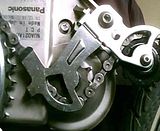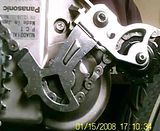This thread is a little confusing as it covers two different issues. The first postings relate to transmission judder/noise on some hub gear bikes with rear wheel tension arrangements, and later posts relate to transmission judder/noise on some 9/10 speed derailleur geared bikes.
Like Tillson, I have followed this with interest because I have never experienced this sort of problem on any of the three hub geared Kalkhoffs (ProConnect, Tasman and Agattu) that I have ridden and worked on.
However, all 3 had the same, simple transmission system:
Wide 1/8" (3.2 mm) chain, anchored in place by wide teeth (3.0 mm) on the 41T Panasonic Chainwheel, and with plenty of slop within the chain for the remaining sprockets in the system to drop into place without needing extreme accuracy in their alignment.
9T motor sprocket 2.2 mm thick
11T Tension jockey wheel 2.1 mm thick
19T Nexus sprocket 2.3 mm thick
Using the "wide chain" strategy, the Panasonic drive unit can readily be matched up to a variety of hub gear units. Successful transmission is determined by chain length/tension.
Derailleur gears are a different kettle of fish because of the huge importance of matching the correct chain to the sprocket cluster. Much of the gearchange action is determnined by the chainlink profile on the outside of each chainlink, and the width of each chainlink is constrained by the fact that it must be able to sit between the sprockets in the cluster.
For Panasonic at the crank/pedal end of the chain, the wide 1/8" chain is no longer an option with derailleur. Two other chain widths have to be considered.
For 5/6/7/8 speed gear clusters, chain width is 3/32" (2.38 mm) - a very common size.
Typically the Panasonic equipment would need teeth of 2.2 mm or less.
For 9/10 speed gear clusters, chain width is 11/128" (2.18 mm).
Typically the Panasonic equipment would need teeth 2.0 mm or less for easy entry and exit into the chain.
I have some Panasonic parts from the early 1/8" chain/hub gear era and the latest 11/128" 9/10 speed era. (I am unsure as to whether there have been other sizes for 3/32" chain)
In particular, the latest 41T derailleur chainwheel is 2.0 mm and the 11T motor sprocket is 2.0 mm (compared with my 9T at 2.16mm).
NRG - I think that it is worth double checking your chainwheel if you are running 9/10 speed chain with a 2.2mm chainwheel. If it is 2.2mm, then it would be worth trying a 2.0mm chainwheel.
James











